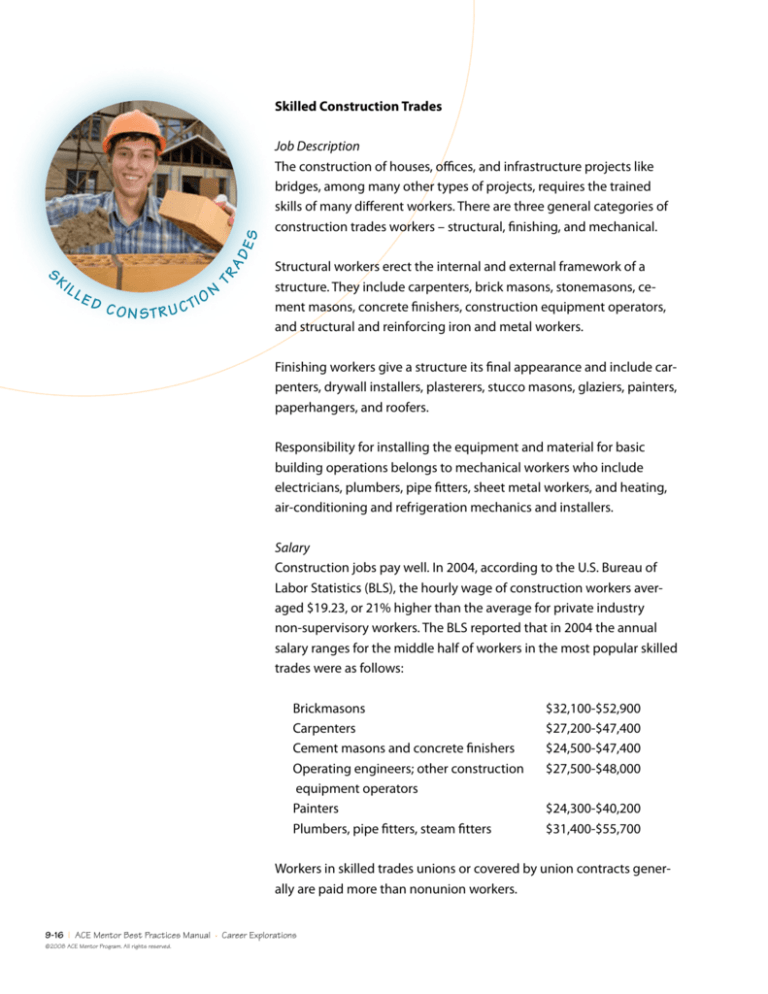
LL
TR
S
KI
AD
ES
Skilled Construction Trades
ED
C O N ST R U C T
IO
N
Job Description
The construction of houses, offices, and infrastructure projects like
bridges, among many other types of projects, requires the trained
skills of many different workers. There are three general categories of
construction trades workers – structural, finishing, and mechanical.
Structural workers erect the internal and external framework of a
structure. They include carpenters, brick masons, stonemasons, cement masons, concrete finishers, construction equipment operators,
and structural and reinforcing iron and metal workers.
Finishing workers give a structure its final appearance and include carpenters, drywall installers, plasterers, stucco masons, glaziers, painters,
paperhangers, and roofers.
Responsibility for installing the equipment and material for basic
building operations belongs to mechanical workers who include
electricians, plumbers, pipe fitters, sheet metal workers, and heating,
air-conditioning and refrigeration mechanics and installers.
Salary
Construction jobs pay well. In 2004, according to the U.S. Bureau of
Labor Statistics (BLS), the hourly wage of construction workers averaged $19.23, or 21% higher than the average for private industry
non-supervisory workers. The BLS reported that in 2004 the annual
salary ranges for the middle half of workers in the most popular skilled
trades were as follows:
Brickmasons
Carpenters
Cement masons and concrete finishers Operating engineers; other construction equipment operators
Painters
Plumbers, pipe fitters, steam fitters $32,100-$52,900
$27,200-$47,400
$24,500-$47,400
$27,500-$48,000
$24,300-$40,200
$31,400-$55,700
Workers in skilled trades unions or covered by union contracts generally are paid more than nonunion workers.
9-16 | ACE Mentor Best Practices Manual · Career Explorations
©2008 ACE Mentor Program. All rights reserved.
Because these salary figures are based on a national average, the salary ranges in different communities may vary from amounts mentioned above.
Education
Employment in one of the skilled construction trades does not require
a college education, although a number of community colleges offer
technical and practical courses relevant to many of the trades.
Many people enter the construction trades through apprenticeship
programs. Lasting several years, these programs offer on-the-job training under the supervision of experienced craftworkers plus formal
classroom instruction. During their training, apprentices receive a
wage that is lower than that of skilled workers. Apprenticeships are
administered by trade unions, trade associations, and local employers.
Skills and Abilities
Fundamental to all work in the skilled construction trades is a pride in
craftsmanship and attention to detail. Manual dexterity, eye-hand coordination, and physical fitness are also critical, as is the ability to read
plans and visualize steps of the construction process. Solid arithmetic
skills are essential for calculations and measurements. Knowledge of
different materials and of tools and machines, including their use and
maintenance, is frequently required. Increasingly, some ability with
computers is also needed.
Job Opportunities
The construction industry faces a critical shortage of workers. Consequently, as older skilled trades workers retire and as the need for new
jobs expands, the growth of jobs in the skilled construction trades will
be strong and steady in the coming years. Between 2004 and 2014,
the Bureau of Labor Statistics estimates that the almost 7 million
workers employed in all construction industry related positions will
grow by more than 11%. The growth rate for several of the most common skilled trades is even higher.
ACE Mentor Best Practices Manual · Career Explorations | 9-17
©2008 ACE Mentor Program. All rights reserved.
OCCUPATION
Number EMPOLYED
2004
% CHANGE
2004-2014
Carpenters
737,000
13.1%
Electricians
430,000
14.2%
Plumbers,
Pipe Fitters,
Steam Fitters
341,000
16.7%
Operating Engineers/
other construction
equipment operators
226,000
13.1%
Painters
195,000
12.1%
Cement Mansons/
Concrete Finishers
179,000
15.9%
Helpful High School Courses
}General science
}General mathematics
}Mechanical drawing
}Vocational/technical subjects
Resources
The following two websites give a broad overview of different career
paths in the construction industry.
}CareerVoyages.gov is a collaborative effort of the U.S. Department
of Labor and the U.S. Department of Education to encourage and
assist young people to pursue careers in high-growth, high-demand
sectors of the economy. Construction is one of the featured sectors.
The interactive website focuses on different skilled trade occupations, describes apprenticeships and college opportunities, and
offers videos depicting the work of several skilled trades. There are
sections for students, parents, and career advisors.
http://careervoyages.gov/construction-main.cfm
9-18 | ACE Mentor Best Practices Manual · Career Explorations
©2008 ACE Mentor Program. All rights reserved.
}Constructmyfuture.com provides an informative, interactive
website with considerable background about different careers in
construction and education and training opportunities. In addition,
many useful links to other organizations and resources can be found
on this web site. The web site has sections for teachers, students,
and parents. http://www.constructmyfuture.com
Many construction industry associations and the U.S. Department of
Labor are sources of helpful information.
}Associated Builders and Contractors, Workforce Development
Department
4250 North Fairfax Drive, 9th Floor, Arlington, VA 22203
Website: http://www.abc.org – Provides information about careers
in many skilled trades as well as leads to education and training
opportunities. The Try Tools web page has sections for high school
students and for teachers and parents.
}Associated General Contractors of America, Inc.
2300 Wilson Boulevard, Suite 400, Arlington, VA 22201
Website: http://www.agc.org – The AGC offers students and teachers
a broad range of helpful information and printed materials. Note
in particular on the AGC website a page titled “Construction Force
Work Path.” It leads to information about many careers in construction and to other useful websites. To find this page, go to the Education and Training section and click on Construction Futures.
}Home Builders Institute
1201 Fifteenth Street NW, Sixth Floor, Washington, DC 20005
Websites: http://www.hbi.org and http://www.buildingcareers.org –
The Home Builders Institute is the workforce development arm of
the National Association of Homebuilders. The two websites listed
here provide helpful information about careers in the home construction industry, especially as relate to several building trades.
} U.S. Department of Labor, Education and Training Administration
200 Constitution Avenue NW, Washington, DC 20210
Website: http://www.doleta.gov – Under the Advancing Your Career
tab, can be found information about skilled trade apprenticeship
programs and background about careers in construction.
ACE Mentor Best Practices Manual · Career Explorations | 9-19
©2008 ACE Mentor Program. All rights reserved.
Trade unions have websites outlining training opportunities and
other industry-related information. The list below is a representative
sample of the larger trade unions.
}International Brotherhood of Electrical Workers
900 Seventh Street NW, Washington, DC 20001
Website: http://www.ibew.org
}International Union of Bricklayers and Allied Craft Workers
620 F Street NW, Washington, DC 20004
Website: http://www.bacweb.org
}International Masonry Institute
The James Brice House, 42 East Street, Annapolis, MD 21401
Website: http://www.imiweb.org
}United Association of Journeymen and Apprentices of the Plumb ing and Pipe Fitting Industry of the United States and Canada
United Association Building, 901 Massachusetts Avenue NW,
Washington, DC 20001
Website: http://www.ua.org
}United Brotherhood of Carpenters and Joiners of America
50 F Street NW, Washington, DC 20001
Website: http://www.carpenters.org
This Fact Sheet, with some additions and modifications, is taken from the National
Building Museum’s Building Blocks: Design Apprenticeship Program curriculum.
9-20 | ACE Mentor Best Practices Manual · Career Explorations
©2008 ACE Mentor Program. All rights reserved.








